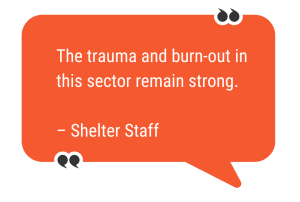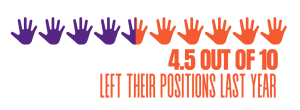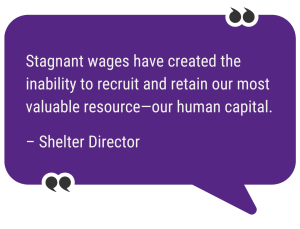Domestic violence shelters provide essential services to thousands of vulnerable Albertans every year.
- Between April 1, 2021 and March 31, 2022, ACWS members sheltered 7,620 abuse survivors and their children.
- They provided outreach support to 7,303 survivors.
- They developed almost 3,000 safety plans with survivors leaving abusive relationships.
- They provided shelter and life-changing programming for over 3,000 children.
- And they answered 65,390 calls for support.
This work provides an invaluable service to Alberta as a whole, but it is especially valuable to Albertans who experience high levels of vulnerability and marginalization, and who are at high risk of serious and imminent harm. In 2021/22, over 70% of clients surveyed by ACWS members had experienced significant exposure to oppression and marginalization, and 72-85% were at severe or extreme risk of being killed by their intimate partner. These survivors need highly specialized support from organizations and service providers that have been designed and educated to meet their needs. Receiving support from a domestic violence shelter can literally mean the difference between life and death.


Demand for domestic violence shelter services is growing.
Shelters are struggling to meet the current levels of demand. In 2021-22 alone, shelters were unable to grant over 19,000 requests from survivors for admission, and 10,000 requests to shelter children who would have accompanied them, due to lack of capacity to house them or safely meet their needs.
While shelters will still actively work with survivors who are turned away to provide them with other resources and supports, these numbers speak to an extraordinary demand for an increase in the services and supports shelters are themselves able to provide.

We anticipate that this demand will continue to grow as survivors who delayed seeking help while pandemic restrictions were in effect reach out for help now. These survivors deserve to receive the support they need. They deserve a domestic violence shelter sector that is able to fully serve them.
The Alberta domestic violence shelter sector hasn’t had a funding increase in 8 years.

The last increase in government funding for staff wages was in 2014-15.
The last increase in government funding for operational costs was in 2015-16.
The cost of living has increased by over 20% since 2014.
In 2021-22 alone, the cost of living in Alberta rose by 6.5%.
Current projects indicate that the cost of living will increase by a further 5.2% in 2023 and 4.3% in 2024.
Shelters are being asked to pay 2023 prices with 2015 dollars, which is an impossible and unfair demand.
Stagnant funding has a negative impact on shelters, staff, and survivors.
The average wage of domestic violence shelter staff is 15% lower than the wage of the average Albertan.
It’s 21% lower than comparable business sector wages.
It’s 33% lower than comparable government wages.

Low wages directly impact the ability of shelters to recruit and retain competent staff.
In 2021-22, the staff turnover rate in domestic violence shelters reached 45%.
This is an unprecedent turnover rate in the Alberta domestic violence shelter sector, and it is 18% higher than the national staff turnover average for domestic violence shelters.


Researchers estimate that it costs domestic violence shelters 30-150% of a staff member’s annual salary to replace them once they’ve left their position. Based on this estimate, in 2021-22 alone, it cost ACWS member shelters more than $2.25 million to fill vacant staff positions.
- More than one third of domestic violence shelter staff report that they work an additional job.
- 92% of those who work an additional job report that they do so to supplement their income.
- 94% of staff who are thinking about leaving their job report that it is because of insufficient pay.
Domestic violence shelters cannot provide maximally effective support to survivors without the ability to recruit and retain competent staff.
Two thirds of shelters report that stagnant wages negatively impact the quality of care they are able to provide to survivors.
Call to Action
ACWS calls upon the Government of Alberta to immediately increase shelter funding to accommodate inflation since the last adjustment.

A cost-of-living adjustment from 2015 funding levels would cost the Government of Alberta approximately $10.3 million. The government has already committed $12.9 million in additional funding to the Office of the Chief Firearms Officer, beyond the annual funding already received by that office, for the purpose of speeding up the process of buying and transferring firearms (Short, 2022). By comparison, the government has increased domestic violence shelter funding by only $2 million since 2016, to fund additional spaces. If Alberta can invest $12.9 million in facilitating speedy gun sales, it can afford to invest $10.3 million in protecting survivors of abuse and gender-based violence.
We call upon the Government of Alberta to work with ACWS to modernize shelter standards, update the shelter staffing model, and review operational funding.
To accomplish this task, ACWS would establish a Domestic Violence Shelter Committee (DVSC) composed of ACWS members, other domestic violence shelters, and government representatives to review ACWS recommendations, including modernization of the staffing model, operational funding, and red tape reduction. The DVSC will provide the minister with recommended actions that stabilize the sector, support survivors, and work toward the end of domestic violence and abuse in Alberta.
Alberta, it’s time to show some love to domestic abuse shelters and the survivors they support. It’s time to show up for shelters as shelters show up for survivors and help ensure that every survivor who reaches out receives the care they need.